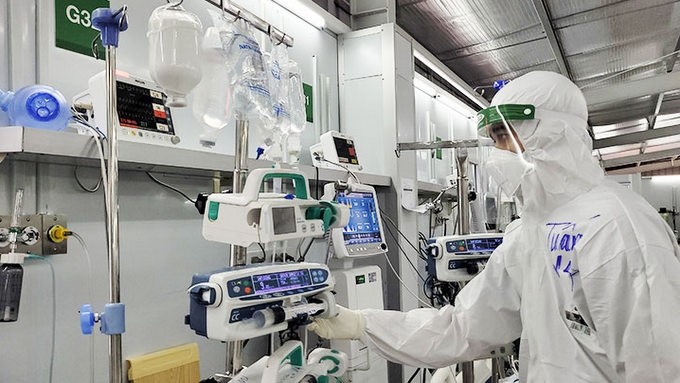The outstanding achievements have proved that Vietnam is on the right track in its pandemic prevention and control.
Deputy Health Minister Nguyen Truong Son said that the most tense period of the fourth fight against COVID-19 fell between August 23 and September 30. During this time, the health sector carried out a testing strategy with the focus on taking a quick test sample every 48 hours (faster than the spread of the SARS-CoV-2 virus). As a result, new positive cases were detected in the earliest manner, so appropriate management and treatment measures were then conducted. In addition, the health sector has also made changes in treatment for COVID-19 infections and new-generation drugs have been put into operation.
According to the Ministry of Health (MOH), by the end of October 8, the number of infections in the community had decreased by 44.7% compared to two weeks ago and 47.3% over the past week. Notably, 91% of confirmed COVID cases have been announced as recovered. Compared to seven days ago, new hospital admissions had decreased by 6.7%, the number of severe and critical cases was down 16.4% and patients relying on invasive mechanical ventilation had fell by 17.1%. 7 out of 62 provinces and cities had passed 14 days without any new cases with 12 others having no new secondary infections.
Based on the results in treatment in recent times and experiences learnt from many countries, in addition to early detection and testing, the MOH will continue to make adjustments, especially the use of several drugs, including Nolnupiravir 400mg for mild cases.
Assoc. Prof. Dr. Luong Ngoc Khue, Director of the Health Ministry's Department of Medical Examination and Treatment, said that with the Delta variant, the fourth outbreak of the pandemic caused a high number of infections and deaths. At times, the mortality rate in Vietnam was up to 2.5%, higher than the world average (2.1%). However, beside the decrease in the number of infections, the death toll has also dropped sharply in recent days. During late August and early September, new COVID-19 cases often hit over 10,000 per day; however, the country has reported only 3,500-5,000 infections per day over the past seven days. In some days, patients given the all-clear were announced at a level five times higher than infections. The country has also seen only 110-130 deaths from disease per day.
The above results were thanks to the drastic direction of the Party and State leaders as well as the joint efforts of the whole political system. The health sector has also implemented many crucial measures, notably professional decisions, to create the positive changes in the fight against COVID-19. The MOH established a standing division for COVID-19 prevention and control in Ho Chi Minh City and the southern provinces. Many working groups have supported Ho Chi Minh City, Binh Duong, Long An, Dong Nai, Can Tho, Vinh Long and Tien Giang in taking measures to control the deaths and infections. There were five measures that are considered pillars to changing the “complexion” of the fight.
Firstly, the decision to put F1 cases under home quarantine has helped reduce the pressure on concentrated isolation facilities and cross-contamination at the centralised quarantine areas.
Secondly, the MOH assigned central hospitals to directly support Ho Chi Minh City and southern provinces in treatment of COVID-19 cases; issued documents guiding the establishment of COVID-19 collection and treatment under the "3-storey tower" model; and performed risk classification of people infected with SARS-CoV-2.
These actions have contributed to reducing mortality while helping hospitals amidst the high number of infections and overloading in COVID-19 treatment facilities.
Thirdly, the MOH agreed to isolate, monitor and care for people infected with COVID-19 at home in epidemic-hit areas such as Ho Chi Minh City. This was a turning point in the treatment strategy, aiming to bring medical treatment closer to the people, especially the bags of treatment drugs (including anticoagulants and anti-inflammatory). In addition, testing, vaccination, provision of oxygen and mobile medical stations were promoted to timely take seriously ill patients to medical facilities.
Fourthly, COVID-19 intensive resuscitation centres were formed; meanwhile, oxygen, medical equipment and COVID-19 treatment drugs were also put into use.
Fifth, the MOH and localities mobilised about 20,000 medical staff and students to support Ho Chi Minh City, Binh Duong, Dong Nai, Long An and southwestern provinces in the fight against the pandemic.
Many experts have said that the recent morality rate is very high, even unimaginable, especially in Ho Chi Minh City. This was certainly a great lesson in pandemic prevention and control. Despite the reduction of infections and deaths, these figures are still high. On the other hand, the country has shifted its anti-epidemic strategy from “zero COVID-19” to safe adaptation to the pandemic, requiring hospitals to make appropriate adjustments in the new period.
There are a large number of people, including positive cases, returning to their hometown from the southern provinces following the implementation of strengthened social distancing measures. Therefore, localities must be very vigilant, improve their response capacity and enhance closer coordination.
















